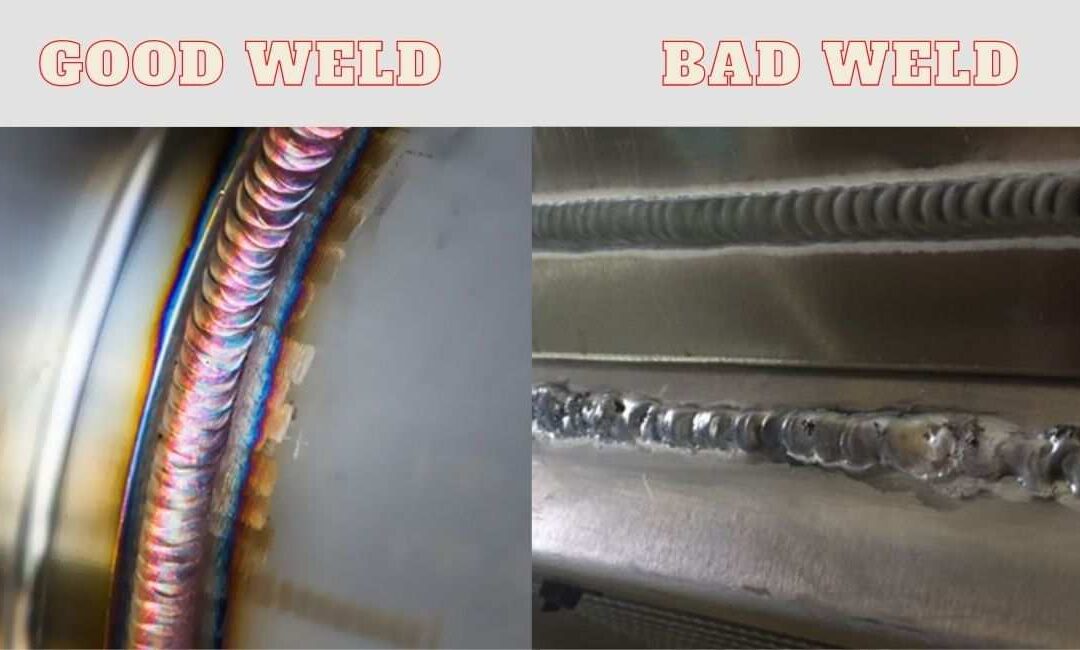Emous towering, skyscrapers, tunnels, bridges and other infrastructure everywhere metal is used in construction. Welding plays a necessary part in every construction project of impressive buildings or towers. Most people know about welding but they don’t know the difference between good weld vs bad weld. There are different types of welding operations nowadays and you should know about them.
Because there are some newbies in this profession that don’t have expertise in how to do good welding. Therefore, it is vital to know the difference between good and bad welding. It will help you to choose an expert welder and welding quality. With many other factors that affect the welding quality, it is also vital which welding helmet is used in the welding operation. Because welding helmet has a great impact on quality welding. This guide will be very helpful for you in knowing the welding quality and the difference between good welding and bad welding.
Table of Contents
Different Kinds of Welding Operations
There are various welding processes, varieties and ways to differentiate the quality of the weld. So, it is significant to understand different welding operations and how to check their quality. Because there are some variations in different kinds of welding.
Therefore the criteria for choosing good weld vs bad weld varies. Here we discuss all kinds of welding and how to decide whether it is good welding or there are defects in welding operations. You can also check detail of undercut welding that is also an major kind of bad weld.
Stick Welding/Arc Welding
Most common and one of the easiest methods of welding are stick welding or arc welding or SMAW. Stick weld can work with various materials like alloy, carbon steel, stainless steel, copper, iron, and aluminum.
Good Stick Weld Signs
A good stick weld always has a right and consistent texture at the end. A good weld should depend on the density of the steel and should not change, and also there should be no holes, cracks or drops of spatter.
Bad Stick Weld Signs
But if you see there are noticeable spatters or cracks, or an inconsistent or undercutting width of the bead, it clearly shows that you have a bad weld vs a good weld.
TIG Welding
TIG stands for tungsten inert gas welding. TIG welding is a very tricky and complicated method as compared to stick welding. Because it needs extra accuracy and skills to attain a process. TIG welding can be used in various types of metals such as aluminum, magnesium and stainless steel. A good TIG welder can achieve the welding process perfectly, but an unprofessional welder also leaves uncertain patterns on the steel or any metal.
Good TIG Weld Signs
A good TIG weld will always seem neat and smooth. If you weld small layered to create a pattern in the weld and if your weld doesn’t have any dust powder or burnout it should be considered very good welding vs bad welding.
Bad TIG Weld Signs
Though, even if you found a horizontal bead without any different pattern, it shows that your TIG weld is done poorly. You must refurbish it because you want to see clear patterns of layered welds, no misalignment and even no burnout.
MIG Welding
MIG welding is also the easiest and most common method of welding. MIG stands for metal inert gas because the welding gun provides energy to an electrode wire to work as the filling of metal that unites elements of metal altogether. Many people are taking up limited training in metal inert gas MIG welding.
Although the process is very simple, it still can result in bad welds if you do not follow the welding procedure properly. MIG welding is mostly used on delicate metals like aluminum and mild steel. Also, check the best MIG welding helmet.
Good MIG Weld Signs
A good MIG welding always must be upright and uniform. There will be no cracks or holes, with no breakage in the weld. But if your weld is extremely delicate and has holes on the bead, it shows that the welding task requires mending again. As compared to TIG weld, MIG weld accomplishes without any difficult patterns. Always make sure that the welding conclusion is steady and exact.
Bad MIG Weld Signs
Unstable or breaks in the weld are indications of bad MIG welding. The weld will need smoothness if there is no accuracy, and also the weld could not have sufficient stability if the bead turns out extremely delicate and tiny. These all points are signs of bad welding vs good welding.
Oxy Welding
Oxy welding is used for maintenance and also for the cutting of metal. Oxy welding is not common as compared to the other weld methods. It is always used for complicated and tricky welding and also used for delicate metals such as bronze, aluminum and copper.
Good Oxy Weld Signs
The best way to spot a good weld vs a bad weld is to look for uniformity. There must be no holes or no indications of melted metal left behind.
Bad Oxy Weld Signs
If you identify bad oxy welding, you will find holes and disarrayed patterns in oxy welding. It is a sign of bad welding vs good welding.
Factors Decide Welding Quality
Whatever process you used for the welding task. Always ensure quality and stability are the most significant standards to decide whether it is a good weld or a bad weld. If a welding task is of poor quality so it could not be as powerful.
Weld Size
The first way is to tell if your weld is good by its size. The weld is in a consistent size from point A to point B. On the left side, the weld is not constant and not evenly smooth. It shows bad weld vs good weld.
Gas Coverage
In wire fodder welding, argon and helium gas are mainly used to conserve the base metal from getting infected by the impurities in the air and most of the time also work as an arc stabilizer. There is a possibility that the base metal could be polluted and controlled to porosity if the airflow is too heavy and the shielding gas is allocated.
Accuracy
The welding task is completed perfectly by the layout measurements. Make sure the welding job gives the necessary process and stability with safety. The look of the welding task fulfills the necessary level of your products. No breaks or craters begin in the bead. Always make the bead have consistent spirals with smooth width and accurate height. It is the indication of good welding vs bad welding.
Porosity
Welding porosity is a welding deformity or deficiency. That is found from detested or unnecessary gasses existing inside the molten weld reservoir during the process of solidification. This causes cavities or pores to appear on the surface or inside the bead. Porosity can arise on the body of a weld or inside the weld bead showing the bad weld vs good weld.
Appearance And Finishing
The complete output of welding always fulfills the design measurements and has nearly no contortion. Good welding vs bad welding satisfies the mandatory stability of the product. By using entire penetration welds that melt and meet the full functionality between the core substances or weld hookups, limited penetration welds should be utilized properly to secure the essential rigidity of metal.
Conclusion of Good Weld vs Bad Weld
Welding is an ability and talent that everyone learns to proceed further. You can choose an inexpensive welder for a little bargain and start understanding how to weld on your own with the help of using the internet as a mentor. However, once you start creating welds by yourself, it could be hard to measure their quality and integrity. Welding is a largely crucial part of the construction system. It can be valuable if you need to build or renovate any metal ventures. It is necessary to understand the various welding methods and new technologies.
FAQs
What process will follow before proceeding to weld metal in gas welding?
Whenever you proceed to weld your product by gas welding, first you should completely heat your object properly and then process weld by gas welding. This process makes your weld strong and gives strength and stability. It is the sign of good weld vs bad weld.
How would you avoid electric shock during welding?
Always secure yourself from the welding work and your ground area because the work area and metal are good electrical conductors. Wear proper defensive and protective equipment and tools, such as rubber pads, gloves, rubber boots and shield screens. If you are performing arc welding in moist or humid circumstances wear welding rubber gloves.
How would you identify good welding vs bad welding?
There are several signs or appearances to specify the good weld vs bad weld. If your product weld is thick, and smooth with accuracy and stability, it means you mend your product with a good weld. A thin layer of weld gives an uneven surface and bad weld. A good weld is always finished with no craters and holes and looks perfect. Making the bead have a consistent wave with smooth width and proper height is also the sign of a good weld vs a bad weld.
How can I determine the metal to obtain good welding?
To specify a good weld vs bad weld, you also understand the category of metal that you want to weld and what the welding method is acceptable for it to obtain good welding vs bad welding.

James is a welding expert, accomplished author, and trusted guide with over 8 years of experience in the industry. With his in-depth knowledge and engaging writing style, James has become a true authority in the field, offering readers and clients invaluable expertise and insights to take their welding skills to new heights.

